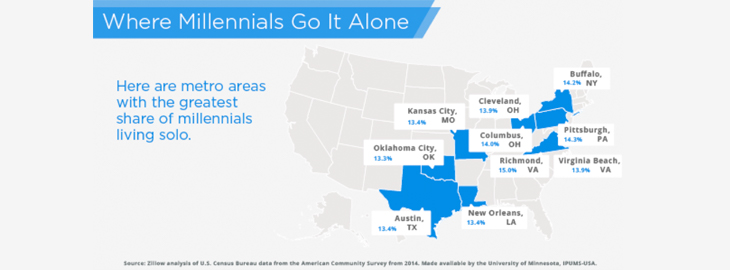
Top Cities for Millennials to Live Alone
Posted On September 7, 2016
(Today’s blog courtesy of Zillow.com. Thanks to Zillow for reaching out and offering this info. Good stuff.)
By Jennifer Riner
Less than 9 percent of Millennials live solo these days – a portion of the population that’s been in decline for the past few years. Because of unaffordable rents and rising home prices, a vast number of young people opt to live with family or friends to cut housing costs that might otherwise send them into the red zone.
Between 2000 and 2013, the percentage of 23- to 34-year-olds living with family increased 46 percent. The no. 1 place where Millennials stay home with their parents is El Paso, Texas, where 33.9 percent live at home. Across the nation, 21 percent of Millennials are still living at home with their parents.
Even more of the population opts to “double up,” or rent with roommates. Between 2006 and 2012, the share of adults living with roommates increased from 27.4 percent to 32 percent. In high-rent cities like San Francisco and New York, splitting the rent is practically a necessity to getting by on a young worker’s salary.
Nevertheless, many individuals prefer to venture out in the world alone – and some are still pulling it off, regardless of current unaffordable housing levels nationwide. Check out the following 10 cities where Millennials rent or own solo.
Richmond, VA
In Richmond, where over 15 percent of homes are considered affordable on a Millennial’s salary, 15 percent of Millennials rent or own alone. The median income within this group is $49,500 annually.
Pittsburgh
Pittsburgh holds the second highest share of solo-minded Millennials with 14.3 percent of them living alone on a median income of $40,000 per year. Across the metro, 17.2 percent of homes are considered affordable for the average millennial budget.
Buffalo, NY
Buffalo’s fair-priced housing stock allows 14.2 percent of Millennials to rent or own without roommates, making a median income of $40,000 per year. Over 13 percent of rentals in Buffalo are reasonably priced for these independent young professionals.
Columbus, Ohio
Fourteen percent of Columbus Millennials rent or own unaccompanied. In the Columbus metro, 11.6 percent of rentals are practical on the typical millennial salary. The median income for Millennials who live alone in Columbus is $38,800 per year.
Virginia Beach, VA
Almost 14 percent of Virginia Beach’s young professional population lives alone. These independent earners have a median income of $50,000 per year and can afford 17.6 percent of the rentals listed in Virginia Beach.
Cleveland
In Cleveland, 13.9 percent of young residents live by themselves and can choose from 6.2 percent of the housing stock on a sensible budget. The median income of Cleveland Millennials who live alone is just $35,000 per year.
New Orleans
New Orleans allows 13.4 percent of Millennials to rent or own without splitting the costs, and 15.8 percent of rentals in NOLA are affordable for the younger generation. The median income among independent Millennials is $40,000 per year.
Austin, Texas
Although 13.4 percent of Austin Millennials choose not to cohabitate, only 1.5 percent of rental properties are financially practical for them. The median income of Austin Millennials who live alone is $40,000 per year.
Kansas City, MO
Over 13 percent of Kansas City Millennials don’t have roommates and hold a median income of $40,000 per year. Over 13 percent of homes for rent in Kansas City are within reason based on that salary level.
Oklahoma City
At no. 10 on the list, 13.3 percent of Oklahoma City’s millennial population rents or owns alone. Almost a quarter (21.6 percent) of homes in Oklahoma City are affordable at the median millennial income level of $40,000 per year.
On the flipside, cities with the lowest share of Millennials living alone include New York (9.7 percent), Los Angeles (8.1 percent), San Francisco (9.4 percent) and Riverside, CA (6.1 percent), despite higher than average millennial incomes and strong annual employment growth.